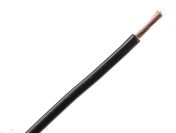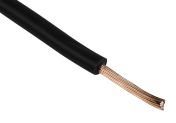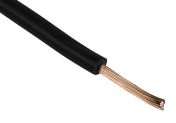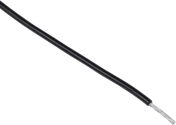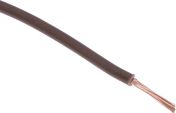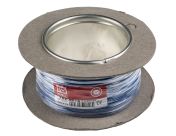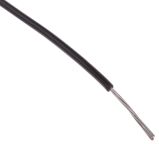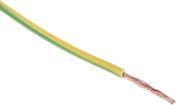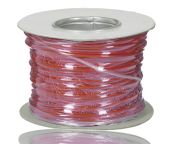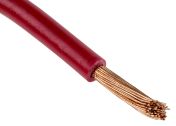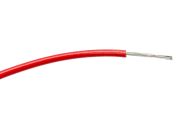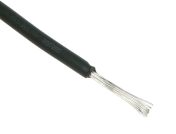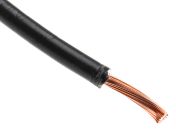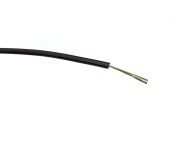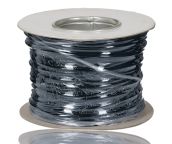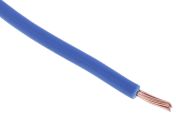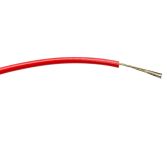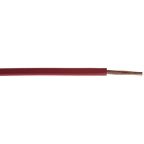Hook Up Wire
Hook-up wire is a term commonly used in electronics and electrical engineering to refer to insulated electrical wires that are used for various electrical connections. These wires typically have a solid or stranded core made of materials like copper or aluminum and are covered with a protective insulating material, such as PVC (polyvinyl chloride) or Teflon (PTFE). The insulation is color-coded to indicate the wire's purpose and to help with proper identification in electrical circuits.
Hook-up wire is available in various gauges (wire diameters) to suit different applications, and it comes in different colors to facilitate organization and identification within electrical circuits. The color coding often follows industry standards or specific conventions, such as red for positive (+) connections and black for negative (-) connections in direct current (DC) circuits.
When working on electrical or electronics projects, it's important to choose the appropriate gauge and type of hook-up wire for your specific application to ensure safety and proper functioning of the circuit.
What Are The Types of Hook Up Wire?
Here are some common types of hook-up wire:
- Single Conductor Wire: This is the most basic type of hook-up wire, consisting of a single insulated conductor. It's suitable for general-purpose use and available in various gauges and insulation materials.
- Stranded Wire: Stranded hook-up wire is made up of multiple smaller strands of wire twisted together. This construction makes it more flexible and suitable for applications where the wire may need to bend or flex.
- Solid Wire: Solid core hook-up wire, or solid electrical wires consists of a single, solid conductor. It's less flexible than stranded wire but is preferred in situations where minimal signal loss or resistance is crucial, such as in high-frequency applications.
- Shielded Wire: This type of wire has an additional layer of shielding, typically made of metal, around the insulated conductor. Shielded wire is used to protect against electromagnetic interference (EMI) and radio frequency interference (RFI). It's commonly used in audio and communication applications.
- High-Temperature Wire: For applications where extreme heat resistance is required, high-temperature hook-up wire is used. These wires are designed to withstand temperatures significantly higher than standard wire.
- Multi-Conductor Cable: While not technically a type of hook-up wire, multi-conductor cables consist of multiple insulated conductors bundled together within a single cable.
- Specialty Wire: Some applications require specialty hook-up wire, such as magnet wire (enamel-coated wire used in electromagnets and transformers), automotive-grade wire (designed for use in vehicles), or even flexible wires.
- Harsh Environment Wire: refers to electrical wiring and cables designed specifically for use in extreme or challenging environmental conditions. These conditions can include exposure to high temperatures, moisture, chemicals, physical abrasion, and other harsh factors that standard wires may not withstand.
Materials and Insulation Types
When it comes to electrical conductors, the most common materials used are copper and aluminum. Copper is highly favored due to its excellent conductivity, durability, and flexibility, making it suitable for a wide range of applications. Aluminum, on the other hand, is used particularly in high-voltage transmission and distribution lines due to its lower cost and lighter weight, although it has lower conductivity compared to copper. Additionally, silver-coated copper is sometimes employed for its superior conductivity and corrosion resistance, often in high-frequency applications or harsh environmental conditions.
The choice of insulation materials for electrical wiring is equally important, with several options available to meet different requirements. PVC (Polyvinyl Chloride) wires are the most common choice due to its cost-effectiveness, good insulating properties, and flame resistance, making it ideal for household wiring and general electrical use. Teflon (PTFE) offers high heat resistance, excellent chemical resistance, and low friction, making it suitable for applications that demand high performance under extreme conditions. Silicone insulation is known for its flexibility and excellent thermal stability, often used in environments with wide temperature variations. Fiberglass insulation provides superior heat resistance and mechanical strength, making it suitable for high-temperature industrial applications.
Whether you need PVC wiring for standard electrical installations or specialized insulation materials for demanding environments, understanding the properties and applications of these materials ensures you choose the right option for your electrical needs.
Role of Color Coding in Standard Practice
The color-coding of electrical cable wires is crucial for safety and efficiency in installations, aiding in identifying the purpose of each wire. Different regions have their own systems, with the IEC standard widely followed, designating brown for live wires, blue for neutral, and green with a yellow stripe for ground. In contrast, the NEC standard in North America designates black, red, or blue for live wires, white or gray for neutral, and green or bare copper for ground.
In the Philippines, the color-coding for cable wires or hook up wires typically follows the IEC standard.
Typical Applications
Hook up wires are essential components in a wide array of applications, from breadboard prototypes to complex electronic devices and internal appliance wiring. They play a vital role in establishing reliable connections between internal components, facilitating efficient transmission of signals and power on circuit boards. These electronic wires connect various elements such as resistors, capacitors, and integrated circuits on PCBs, offering flexibility and insulation ideal for intricate designs.
Available in various gauges and colors, hook up wires aid in organization and identification of connections, crucial for both prototyping and final assembly. Whether in simple setups or sophisticated devices, hook up wires are indispensable wires for electronics, for creating functional and efficient electronic systems, ensuring effective communication between components and overall performance and reliability. Selecting the right type of electronics wire is crucial to meet specific electrical and mechanical demands of any project.
How Professionals Select the Correct Wire
When choosing the right hook up wires, professionals ensure the wire’s voltage rating exceeds the application’s maximum voltage to prevent the breakdown of insulation material. The wire's gauge must match or exceed the current requirements to avoid overheating. Environmental conditions like temperature, humidity, and chemical exposure can also adversely affect wire performance, so selecting appropriate insulation materials like PVC, Teflon, or silicone is crucial. Additionally, professionals also consider the mechanical stress that the electrical wire will be put through, such as bending or vibration.
Buy Hook Up Wires from RS Philippines
Looking for high-quality hook up wires in the Philippines? Look no further than RS as your trusted supplier! With a wide range of cable wire options, we provide top-notch solutions to meet your electrical needs. Ensure your projects are safe and efficient by choosing RS Philippines as your go-to supplier. Head to our website today to find out more!
